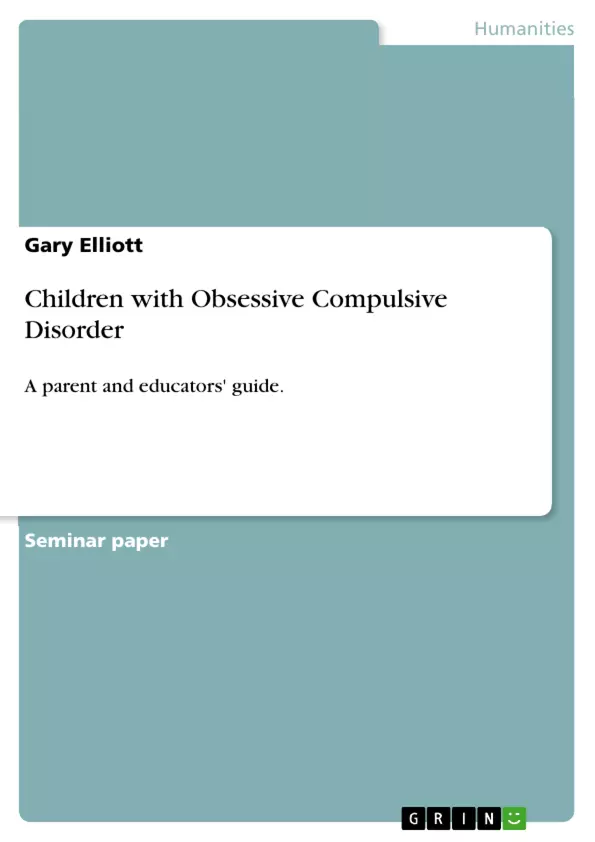Obsessive compulsive disorder initially was thought to be a relatively rare disorder, but is now recognized as a common psychiatric issue with an estimated lifetime prevalence of 1.9 to 3.3%. The United States has a prevalence rate for this anxiety disorder of one in every one hundred children. Research among the five to six million U.S. adults living with OCD discovered that 50 percent said that their symptoms began in childhood. A statistic like this drives home the need for both parents and educators to have a thorough understanding of the signs and symptoms of OCD in children in an attempt to identify and address the disorder as early as possible in the child’s life. One of the greatest stumbling blocks to seeking professional attention for a child is the myths and misconceptions attached to the behaviour of a child suffering with this disorder.
Mark suffers with Obsessive-Compulsive Disorder (OCD), “characterized by obsessions or compulsions (usually both) that cause marked distress, are time consuming (take more than 1 hour a day), or significantly interfere with functioning.”(Phillips 2009:282). An obsession is defined as a recurrent, persistent, and intrusive thought, impulse or image that is difficult to dismiss despite its disturbing nature. A compulsion is often known as a ritual. It is excessive repetitive behaviour (such as hand washing as in Mark’s case above) or mental acts (such as counting) that are performed to try to decrease the anxiety caused by an obsession. These compulsions are usually difficult to resist or control. (p. 279)
Inhaltsverzeichnis (Table of Contents)
- Introduction
- What is Obsessive Compulsive Disorder?
- The Diagnostic Criteria for Obsessive Compulsive Disorder
- Why are some children more vulnerable to OCD?
- The Symptoms of Obsessive Compulsive Disorder
- Treatment
- Conclusion
Zielsetzung und Themenschwerpunkte (Objectives and Key Themes)
This guide aims to provide parents and educators with a comprehensive understanding of Obsessive Compulsive Disorder (OCD) in children. It explores the nature of the disorder, its causes, symptoms, and treatment options. The text emphasizes practical strategies for supporting children with OCD, empowering parents and educators to create a more understanding and supportive environment.- Understanding the nature of Obsessive Compulsive Disorder (OCD)
- Identifying the symptoms and diagnostic criteria for OCD in children
- Exploring the potential causes and risk factors for developing OCD
- Presenting effective treatment strategies for children with OCD
- Empowering parents and educators to support children with OCD
Zusammenfassung der Kapitel (Chapter Summaries)
The introduction provides a general overview of Obsessive Compulsive Disorder (OCD) and its impact on children. It highlights the importance of early identification and intervention. The second chapter delves into the definition and characteristics of OCD, explaining the nature of obsessive thoughts and compulsive behaviors. It explores the underlying mechanisms and psychological processes involved. The third chapter examines the diagnostic criteria for OCD as outlined in the Diagnostic and Statistical Manual of Mental Disorders (DSM). It provides clear and concise guidelines for recognizing the disorder in children. The fourth chapter examines potential factors that might increase a child's vulnerability to OCD, including genetic predisposition, environmental influences, and developmental factors. The fifth chapter presents a comprehensive overview of the common symptoms associated with OCD in children, including both obsessive thoughts and compulsive behaviors. It offers specific examples and real-life scenarios to illustrate the diverse range of manifestations. The sixth chapter explores various treatment options for children with OCD, focusing on both pharmacological and psychological interventions. It emphasizes the importance of individualized treatment plans based on the child's specific needs and circumstances.Schlüsselwörter (Keywords)
This guide focuses on Obsessive Compulsive Disorder (OCD), its diagnosis, treatment, and management in children. Key themes include childhood mental health, anxiety disorders, cognitive behavioral therapy, exposure therapy, and supportive parenting strategies.- Arbeit zitieren
- Gary Elliott (Autor:in), 2010, Children with Obsessive Compulsive Disorder, München, GRIN Verlag, https://www.grin.com/document/275076



